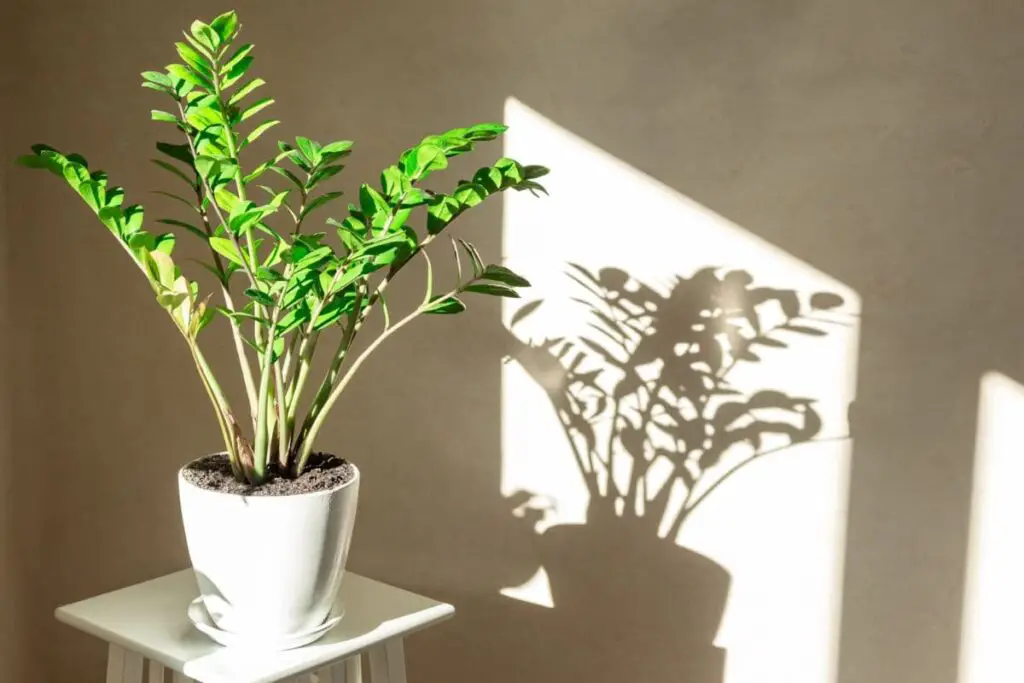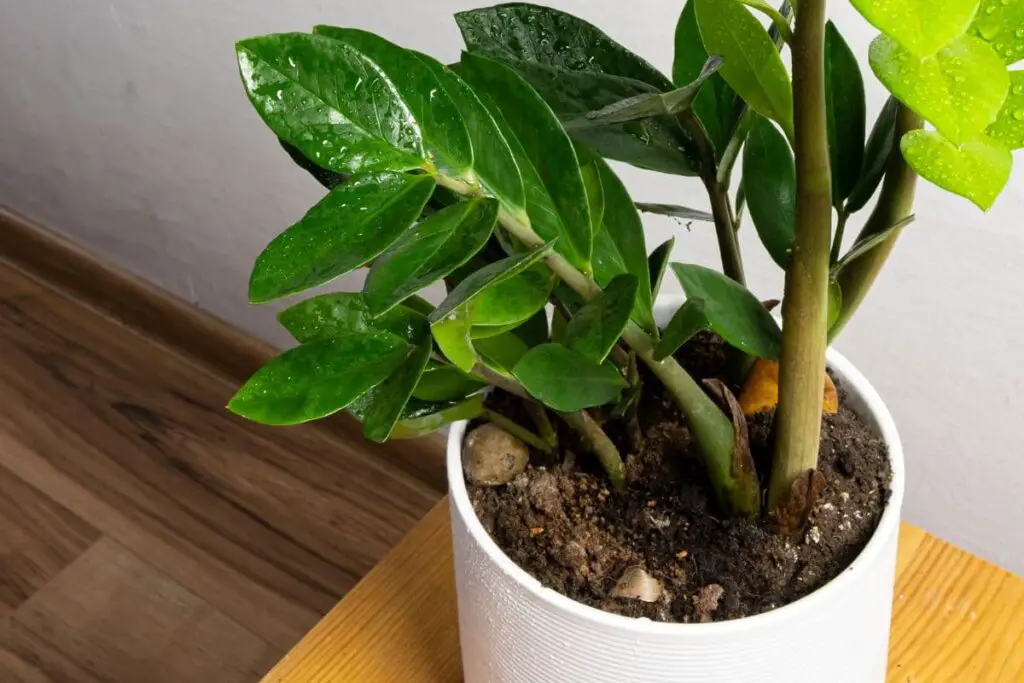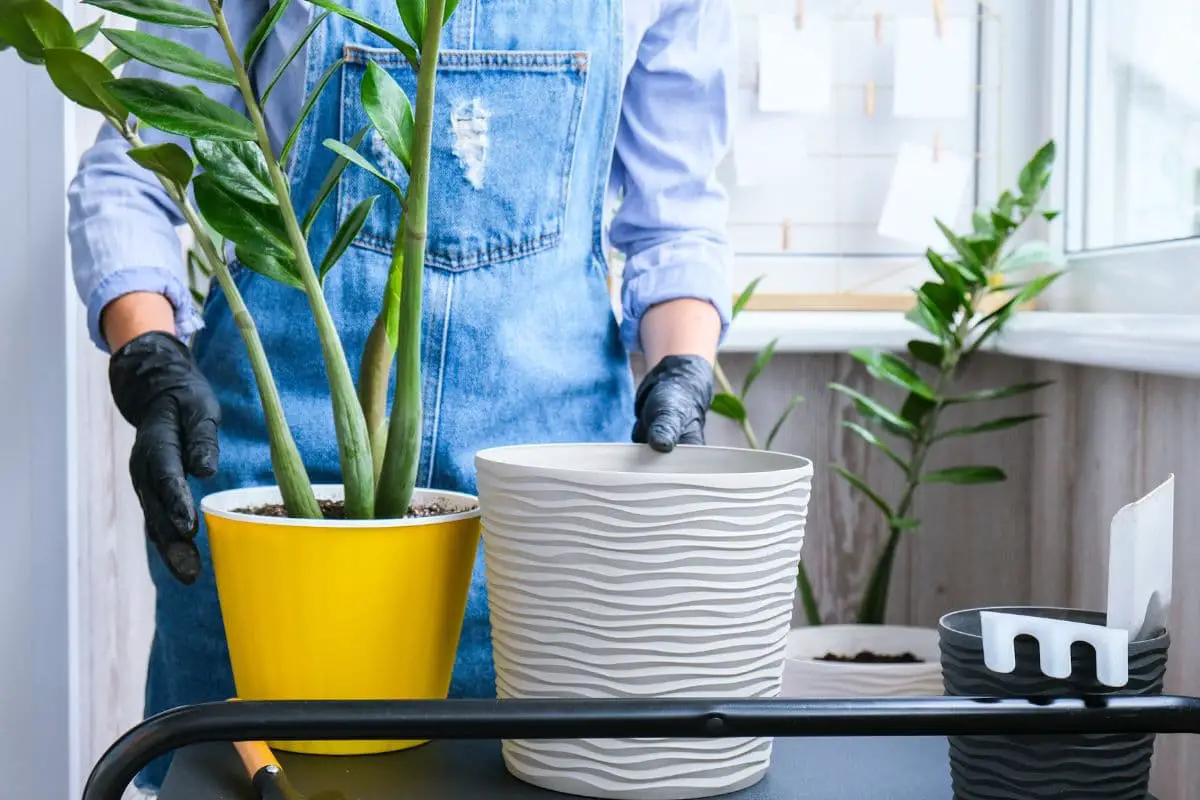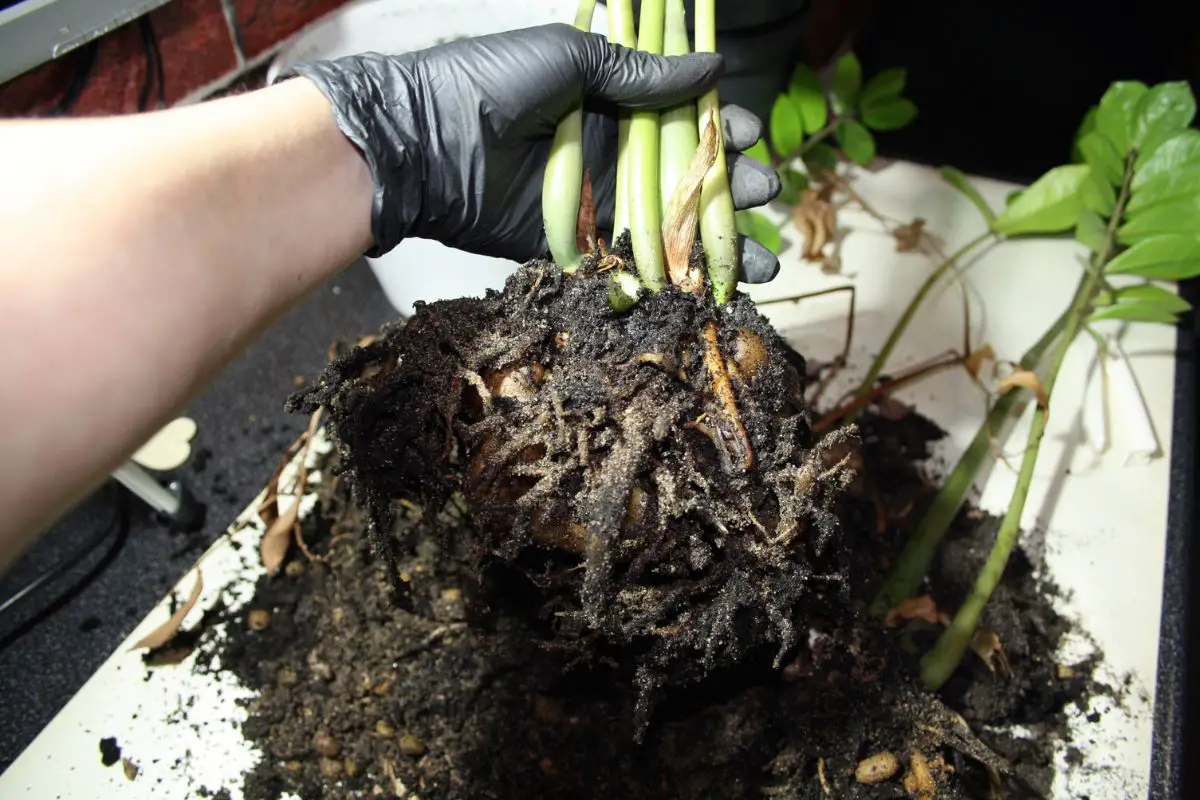ZZ plants are generally low-maintenance indoor plants, so it can be alarming to see them leaning or growing lankier with sparse leaves. These issues can sometimes be observed with plants growing in a poor environment.
ZZ plants get leggy or lean toward the windows or light bulbs when they don’t receive enough sunlight. The stems can also lean or droop if the rhizomes are exposed or rotting from overwatering. Improper potting, nutrient imbalance, and transplant shock can also cause leaning.
It’s crucial to identify and address the underlying issues promptly to preserve the health and improve the aesthetics of your plant. This article will delve into the issues and their symptoms, and offer solutions to fix them.

ZZ Plant Growth: An Overview
In their native habitat, Zamioculcas zamiifolia or ZZ plants spread through underground, potato-like stems called rhizomes. New stems grow vertically through these rhizomes and reach 2-4 feet (0.6-1.2 m) tall.
They’re compact with glossy green leaves growing out of thick, upright stems. Depending on the variety, the leaves can grow in alternating or opposite patterns. The nodes are spaced about an inch (2.5 cm) or less.
Due to the low-moisture and low-light tolerance of ZZ plants, they’re a favorite among beginner gardeners or those who don’t have plenty of time for extensive plant care. These plants essentially tolerate neglect much better than other houseplants.
However, ZZ plants can also communicate when they’re too stressed and need better conditions. The stems usually become leggy or start leaning when severely deprived of light, water, space, or nutrients.
When your plant becomes leggy, the stems grow sideways and the leaves are spaced more widely. The leaves may also appear smaller or turn yellow.
This can negatively affect the overall health and appearance of your plant.
Reasons for Leggy and Leaning Plants
Many factors can cause your ZZ plant to become leggy or lean.
Here are the causes and their respective solutions:
Insufficient Light
In the wild, ZZ plants grow under dappled sunlight all day. They don’t like direct sunlight, which can burn their leaves and turn them yellow or brown.
This low-light requirement makes them perfect as indoor plants. They can grow near a northern window, which receives the least amount of daylight in the northern hemisphere.
However, the best spot for them is 4-8 feet (1.2-2.4 m) away from an eastern window, where they can receive bright, indirect morning sunlight.
Signs of Lack of Light
You’ll know that your ZZ plant isn’t getting enough light when:
- It starts to lean toward the windows or bulbs.
- The stems on the sun-deprived side of the plant become leggy.
- The leaves become pale and new growths are widely spaced.
How To Fix Improper Lighting
You can fix the problem through the following steps:
- Cut the leggy stems down to less than an inch (2.5 cm) above soil level using sterile shears. They won’t recover their normal appearance. Cutting them will encourage your plant to grow new, upright stems—although it can take a long time to grow to mature size.
- Place the container closer to the window, but keep it away from direct sunlight. You can place it as close as 4 feet (1.2 m) to a bright window. If you need to bring it closer, you can hang sheer curtains at midday to filter the light.
- Rotate the pot by 90-180° every time you water your plant. This will prevent future issues with legginess.
- Alternatively, place a full-spectrum 40-watt grow light a foot (30 cm) above your plant. Keep it on for 10-12 hours daily to encourage the new stems to grow upright.

Limited Space for Root Growth
If the plant is falling over or leaning but not in the direction of the light, it could be due to being rootbound. When the roots outgrow their pots, the restricted space may push the outermost ZZ stems to lean outward instead of growing vertically.
Signs You Should Repot
Here are the signs your plant needs repotting:
- The rhizomes or bulbs are exposed.
- The roots are growing out of the surface or the drainage holes.
- The stems growing from the exposed rhizomes along the edges of the container grow sideways.
How To Repot or Divide Your Plant
You can fix this issue by repotting or dividing your plant in spring.
Here are the steps:
- Carefully unpot the plant and loosen the soil without damaging the roots.
- Inspect the roots for easy division spots. A good division should have a firm rhizome with 1-2 upright, non-leggy stems and healthy roots at least 2 inches (5 cm) long.
- Gently disentangle the roots between rhizomes.
- Prune damaged or decayed roots using sterile shears.
- Plant each division into a new pot and fresh soil. (I’ll discuss these in more detail below).

Overgrowth
ZZ plants can become top-heavy as they grow bigger and the outermost stems will naturally lean by up to 45°. Any more and your plant will start looking messy. Some older stems in the middle may also look taller than the rest.
Tips for Pruning ZZ Plants
To improve your plant’s appearance, you can prune it in the following ways, ideally in spring:
- Taller stems that stand out: You can cut the stem at a point where it’ll be the same height as the rest. However, note that the cut stem will not grow longer.
- Stems with older leaves: ZZ plant leaves start to turn yellow or become wrinkly as they get older. Cutting them down to soil level will re-invigorate your plant and reduce the risk of new stems leaning,
Avoid pruning your plant too much outside of the growing season in spring. ZZ plants grow slowly, and it can take some time before new stems can replace the cut ones.
You can also divide and repot your plant following the same tips above. If multiple stems are healthy but leaning too much, you can stake your plant as you repot it.
How To Add Stakes Properly
Here’s how to add stakes into the pot and soil:
- Prepare two bamboo stakes ¼-½ (0.6-1.3 cm) in diameter and 6 inches (15 cm) taller than your plant’s stems.
- Place the stakes alongside the bulbs. Keep the stakes 3-4 inches (7.6-10 cm) apart and 6 inches (15 cm) deep into the soil. Doing this soon after repotting ensures you don’t puncture the bulbs.
- Tie the unruly stems to the stake using soft twist ties. You can tie multiple stems against each bamboo stake. Use two ties per stem spaced 3-4 inches (7.6-10 cm) apart.

Improper Potting
The wrong pot size can also cause ZZ plants to lean or fall over.
Here are some examples of improper potting:
- Lightweight pots: As discussed, ZZ plants can become top-heavy. Planting them in lightweight or plastic pots that can’t support the weight of the foliage will cause the stems to droop or the entire plant to fall over.
- Shallow pots: ZZ plants can quickly outgrow shallow pots and expose the bulbs, which can lead to leaning stems.
- Oversized pots: Overpotting can increase the risk of overwatering and root rot in ZZ plants. This can also turn the rhizomes and vertical stems mushy.
To fix this problem, you must repot your plant in an appropriate container.
Choosing the Right Pot Size & Material
Here are some tips to choosing the right pot for ZZ plants:
ZZ plants need 2-3 inches (5-7.6 cm) of soil space below the rootball. The topmost bulbs must also be covered by an inch (2.5 cm) of soil to prevent bulb dehydration and leaning of new stems. There should also be 1-2 inches (2.5-5 cm) of space around the plant to accommodate growth for the next 2-3 years.
Choose heavy materials like terracotta or ceramic to support the weight of your growing plant.
Pro tip: Unglazed terracotta is the best material for ZZ plants because it’s heavy and breathable. It can effectively support the plant’s weight and prevent overwatering issues.
Overwatering and Underwatering
Overwatering can cause your plant to lean or fall over in different ways, depending on the severity.
- Mild: A strong stream of water can erode the soil on the surface. The excess water will also drain out some soil particles through the drainage holes. These conditions may expose the bulbs, causing the stems to lean.
- Severe: The roots and bulbs will rot when kept in constantly wet soil. They eventually become mushy (as well as the base of the stem) and your plant will start falling over.
Tips for Fixing Overwatering
You can fix overwatering by:
- Repotting your plant in a new pot and fresh soil mix with better drainage. I recommend using standard succulent mix or a homemade mix with equal parts compost and perlite/coarse sand.
- Propagating leaf or stem cuttings. In case the plant has severe root or bulb rot, the only option left is to collect healthy cuttings and root them. Unfortunately, it can take 1-3 months for the cuttings to grow roots and several years for your plant to reach mature size.
How To Fix Underwatering
ZZ plants are drought-tolerant and can tolerate underwatering better than overwatering. However, underwatering can also weaken the plant’s structure, especially if you don’t water your plant for at least 3 months.
A severely dehydrated ZZ plant will use up the moisture stored in the rhizomes and vertical stems. Once the moisture is depleted, the stem will likely droop, and the leaves may even fall off in severe cases.
You can fix this issue using the following tips:
- Water your plant deeply. If the drooping is minimal, your plant should perk back up after 1-2 sessions of deep watering.
- Soak the pot in water with a wetting agent for 5 minutes. This is helpful if the soil has become hydrophobic from lack of moisture for extended periods.
- Repot your plant. If the soil has significantly lost its structure and is depleted of nutrients, it’s best to move your plant to a new pot with fresh soil rich in organic matter.
Good Watering Practices
In addition to the fixes above, it’s also crucial to water your plant properly to help it recover.
Here are the basic watering steps for ZZ plants:
- Water your plant thoroughly until the excess drains out of the holes.
- Let the pot sit on a drip tray until the excess stops dripping.
- Place your plant back on its saucer. Watch out for pooling water on the saucer and throw it out.
- Check the soil 10-14 days after watering to check the soil moisture. You can use a wooden chopstick but be careful not to poke through and injure the bulbs. The interval can take longer during the cold season if your indoor temperatures are lower.
- Water your plant deeply as soon as the upper half of the soil is dry.
Transplant Shock
Newly repotted ZZ plants need adequate care to ensure they recover from stress.
Transplant shock can cause the stems to droop or fall over if your plant is exposed to any of the following conditions:
- Too much or too little water
- Intense or insufficient light
- Temperatures outside your plant’s preferred range
- Overfertilization
- Improper repotting (wrong pot size or soil mix)
Fixing Transplant Shock
You can fix this problem with the following tips:
- Water your plant properly using the watering guidelines discussed above.
- Keep your plant in bright, indirect light and rotate the pot regularly.
- Maintain temperature levels between 65 and 85 °F (18 and 29 °C). Avoid drastic changes by keeping your plant away from drafty windows or vents.
- Avoid fertilizing your plant immediately after repotting. ZZ plants are not heavy feeders and they can feed off of the compost in the new soil mix until the next growing season. That’s why it’s important to use high-quality compost.
- Propagate healthy leaves. If you repotted your plant in the wrong container or soil mix, it might not survive another repotting session so soon. You can instead save your plant by propagating it through leaf cuttings.
Nutrient Imbalance
ZZ plants need sufficient nitrogen levels to maintain their vibrant green leaves. If there’s nitrogen deficiency, the plant may grow awkwardly with the following symptoms:
- Leggy growth can occur on any side of the plant, not only in the sun-deprived area
- Yellowing leaves starting from the bottom, older ones
- Stunted growth
Conversely, too much fertilizer can suck out the moisture from the roots and rhizomes. The dehydrated rhizomes will lead to weaker stems that are more susceptible to falling over.
You can fix this issue by fertilizing your plant properly.
Fertilization Tips
Here are some helpful tips for fertilization:
- Use high-quality finished compost in the initial soil mix.
- Feed your plant slow-release 10-10-10 NPK fertilizer the following spring.
- Ensure there’s an inch (2.5 cm) of soil above the bulbs when you sprinkle the fertilizer. The granules can heat up when watered and this reaction can damage the bulbs if they’re in direct contact.
- Add another dose of fertilizer in early summer if the plant shows the signs of nutrient deficiency listed above.

Preventive Measures for Upright and Healthy Growth
Due to their slow-growing nature, it can be troublesome to fix legginess or leaning in ZZ plants. It can take several months up to two growing seasons or adequate care before your plant can achieve a better appearance.
Therefore, it’s more practical to observe proper care and preventive measures to begin with.
Routine Care Schedule
ZZ plants don’t require extensive care as much as other houseplants. I recommend using a plant calendar or setting an alarm to ensure you don’t skip out on their care requirement—however minimal.
Here are some practical tips:
- Set a reminder 10-14 days after watering to check the soil moisture.
- Use this time to also inspect your plant for signs of pests, diseases, or stress.
- Wipe the dust off the leaves using a clean cloth. You can also mist the leaves lightly before wiping off the dirt. Doing this shortly before watering will reduce the risk of overwatering.
- Rotate your plant every time you water it. You can choose between a quarter or a half turn. Whichever you choose, stick by it, and do it in only one direction (ex. clockwise).
- Fertilize your plant in early spring when you notice growth spurts. Any necessary supplemental fertilization must be applied 2-3 months later.
Seasonal Considerations
In a perfect environment where you can maintain the light, water, and temperature conditions around your ZZ plant all year round, it’ll continue to grow at an even pace.
However, the lower temperatures and drier conditions in colder climates will trigger your plant to grow more slowly.
The soil will dry out faster in hotter and brighter conditions. You must check the soil 10-14 days after watering in spring and summer to keep it from becoming bone dry. Conversely, the interval between watering sessions can increase in winter.
Make it a habit to check the soil moisture before watering your plant.
Final Thoughts
ZZ plants are highly valued due to their vibrant leaves and upright growth. They lose their aesthetic appeal when they become leggy or the stems start leaning or falling over.
It’s essential to monitor your plant regularly to catch any signs of stress or awkward growth early and promptly diagnose and address the issue.
Refer to the tips above on how to identify and fix the issues to ensure your ZZ plants remain in the best shape and continue to thrive in your home.







